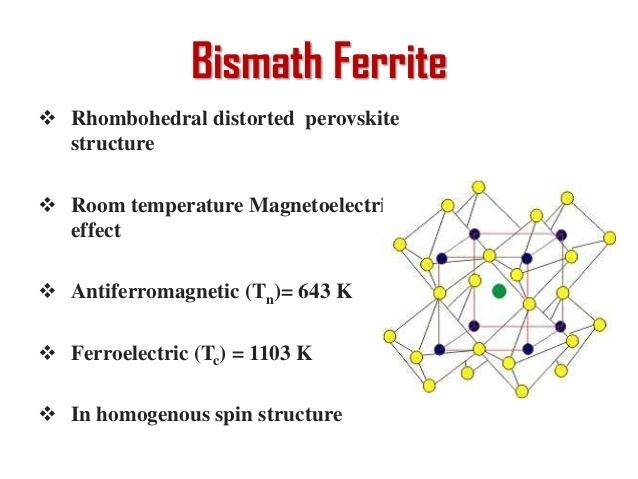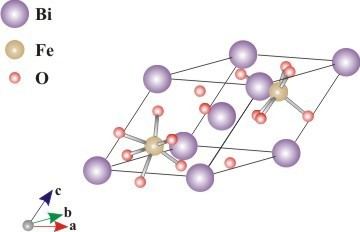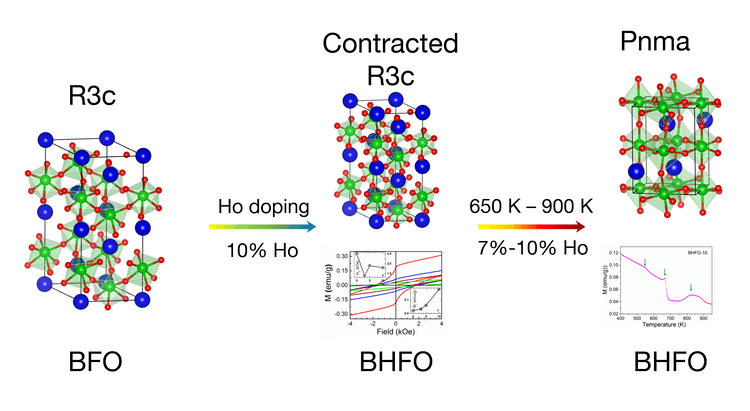 | ||
Degradation of dyes and organic compound using bismuth ferrite nanoparticles
Bismuth ferrite (BiFeO3, also commonly referred to as BFO in materials science) is an inorganic chemical compound with perovskite structure and one of the most promising multiferroic materials. The room-temperature phase of BiFeO3 is classed as rhombohedral belonging to the space group R3c. It is synthesized in bulk and thin film form and both its antiferromagnetic (G type ordering) Néel temperature and ferroelectric Curie temperature are well above room temperature (approximately 653 K and 1100K, respectively). Ferroelectric polarization occurs along the pseudocubic direction (
Contents
- Degradation of dyes and organic compound using bismuth ferrite nanoparticles
- Sample Preparation
- Solid state synthesis
- Single crystal growth
- Chemical routes
- Thin films
- Applications
- Photovoltaics
- References

Sample Preparation

Bismuth ferrite is not a naturally occurring mineral and several synthesis routes to obtain the compound have been developed.
Solid state synthesis

In the solid state reaction method bismuth oxide (Bi2O3) and iron oxide (Fe2O3) in a 1:1 mole ratio are mixed with a mortar, or by ball milling and then fired at elevated temperatures. The volatility of bismuth and the relatively stable competing ternary phases Bi25FeO39 (sillenite) and Bi2Fe4O9 (mullite) makes the solid state synthesis of phase pure and stoichiometric bismuth ferrite challenging. Typically a firing temperature of 800 to 880 Celsius is used for 5 to 60 minutes with rapid subsequent cooling. Excess Bi2O3 has also been used a measure to compensate for bismuth volatility and to avoid formation of the Bi2Fe4O9 phase.
Single crystal growth

Bismuth ferrite melts incongruently, but it can be grown from a bismuth oxide rich flux (e.g. a 4:1:1 mixture of Bi2O3, Fe2O3 and B2O3 at approximately 750-800 Celsius). High quality single crystals have been important for studying the ferroelectric, antiferromagnetic and magnetoelectric properties of bismuth ferrite.
Chemical routes

Wet chemical synthesis routes based on sol-gel chemistry, modified Pechini routes or hydrothermal synthesis have been used to prepare phase pure BiFeO3. The advantage of the chemical routes is the compositional homogeneity of the precursors and the reduced loss of bismuth due to the much lower temperatures needed. In sol-gel routes, an amorphous precursor is calcined at 300-600 Celsius to remove organic residuals and to promote crystallization of the bismuth ferrite perovskite phase, while the disadvantage is that the resulting powder must be sintered at high temperature to make a dense Polycrystal.
Thin films

The electric and magnetic properties of high quality epitaxial thin films of bismuth ferrite reported in 2003 revived the scientific interest for bismuth ferrite. Epitaxial thin films have the great advantage that they can be integrated in electronic circuitry. Epitaxial strain induced by singly crystalline substrates with different lattice parameters than bismuth ferrite can be used to modify the crystal structure to monoclinic or tetragonal symmetry and change the ferroelectric, piezoelectric or magnetic properties. Pulsed laser deposition (PLD) is a very common route to epitaxial BiFeO3 films, and SrTiO3 substrates with SrRuO3 electrodes are typically used. Sputtering, metal organic chemical vapor deposition (MOCVD) and chemical solution deposition are other methods to prepare epitaxial bismuth ferrite thin films. Apart from its magnetic and electric properties bismuth ferrite also possesses photovoltaic properties which is known as ferroelectric photovoltaic (FPV) effect.
Applications
Being a room temperature multiferroic material and due to its FPV effect bismuth ferrite have several applications in the field of magnetism, spintronics, photovoltaics etc.
Photovoltaics
In FPV effect a photocurrent is generated in a ferroelectric material under illumination and its direction is dependent upon the ferroelectric polarization of that material. So, FPV effect has a promising potential as an alternative to conventional photovoltaic devices. But the main hindrance is that a very small photocurrent is generated in ferroelectric materials like LiNbO3, which is due to its large bandgap and low conductivity. In this direction bismuth ferrite has shown a great potential since a large photocurrent effect and above bandgap voltage is observed in this material under illumination. Most of the works using bismuth ferrite as a photovoltaic material has been reported on its thin film form but in a few reports researchers have formed a bilayer structure with other materials like polymers, graphene and other semiconductors. In a report p-i-n heterojunction has been formed with bismuth ferrite nanoparticles along with two oxide based carrier transporting layers. In spite of such efforts the power conversion efficiency obtained from bismuth ferrite is still very low.
